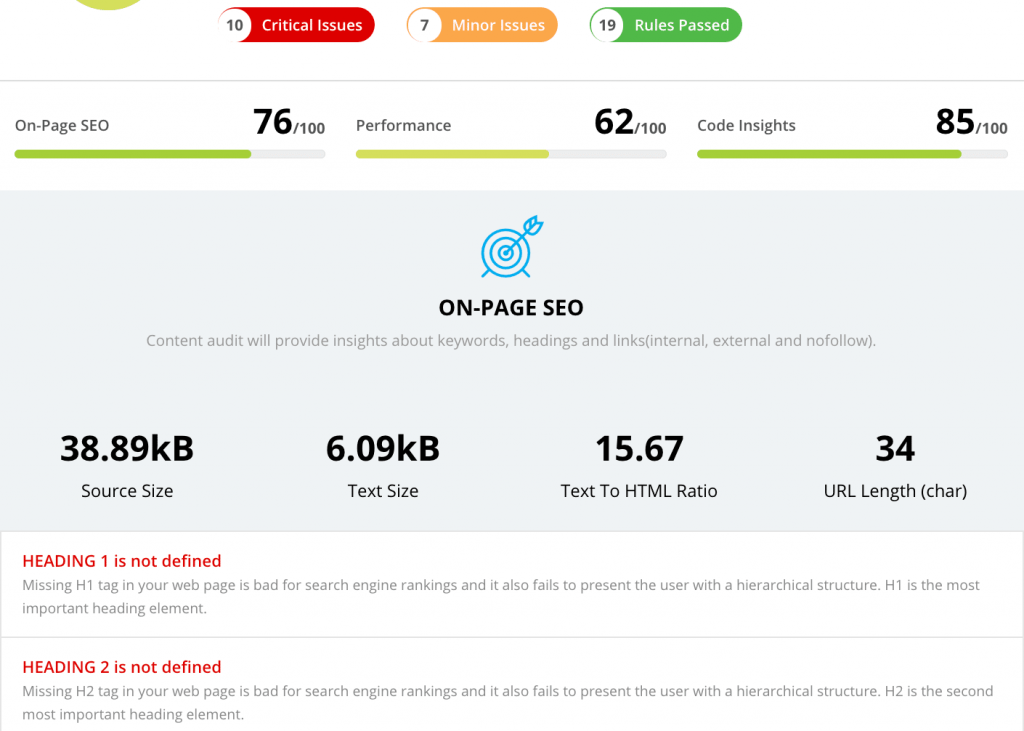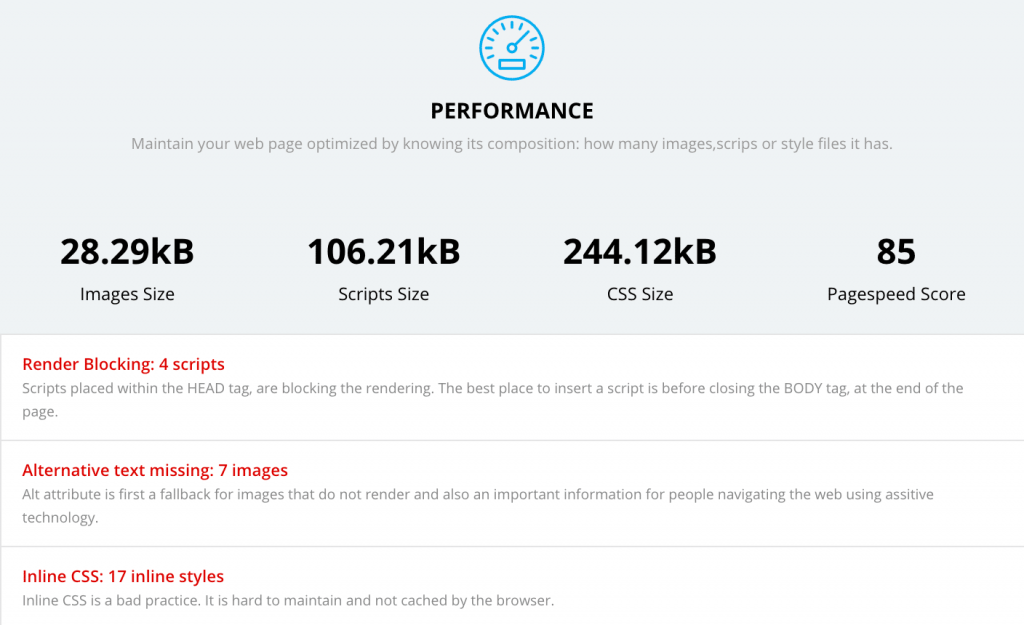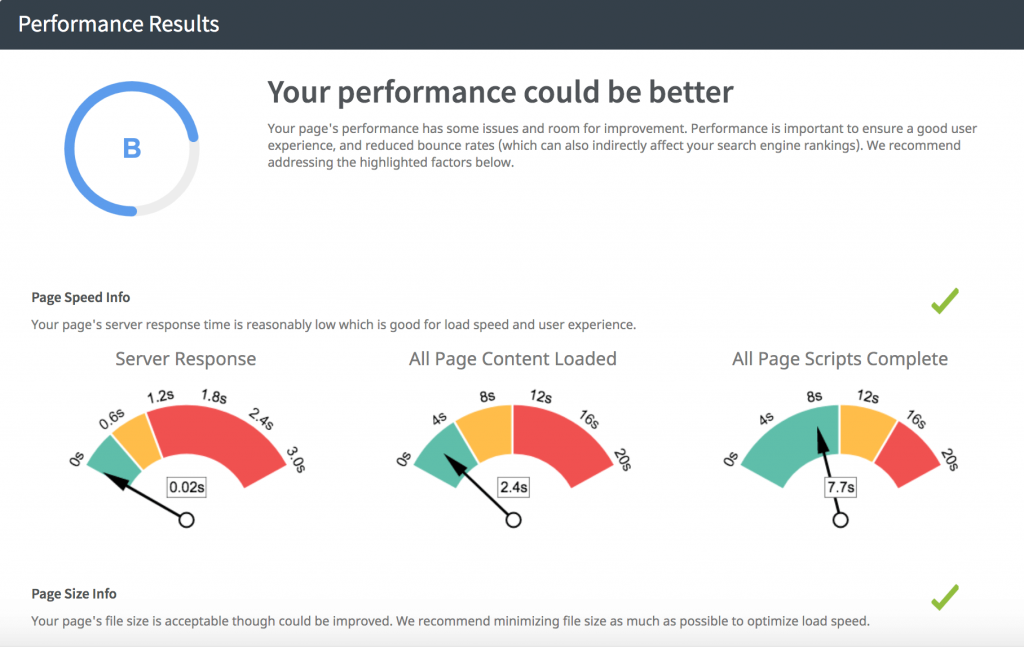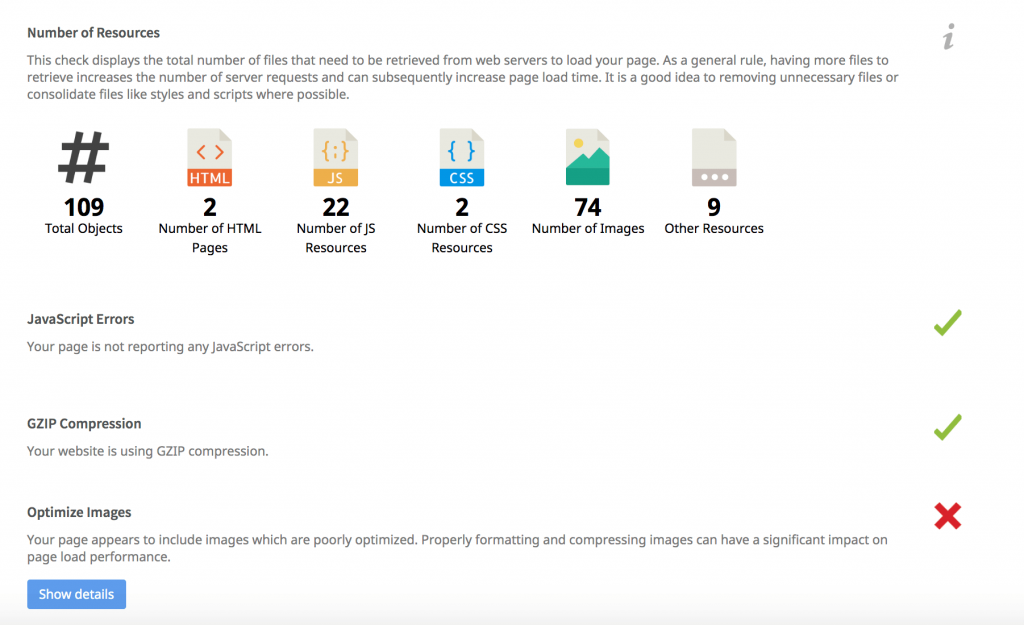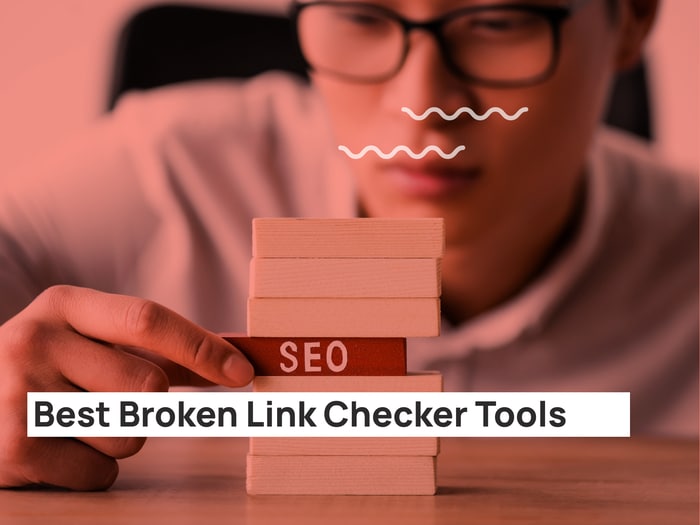Why do we need an SEO audit?
An SEO audit establishes a technical and semantic diagnosis of your website. It also provides an analysis of your visibility in SERPs. This data allows us to find all website optimization opportunities and ways to boost your website visibility and rankings in search engine search results.
In an SEO audit process, our UPQODE team perform an in-depth analysis of the website by checking multiple ranking factors. Based on the audit results, we highlight how efficient separate elements of your website are. We identify SEO errors and explain how to fix them.
SEO on-page audit key points
- Major domain characteristics
- Header tags verification
- Pages’ Titles
- Meta Descriptions
- Pages’ URL structure
- Images optimization analysis
- Content analysis
- Keyword density
- Internal linking analysis
- Backlinks analysis
- Page speed verification
- Popularity in social media
- Usability and technical analysis
Basic technical analysis
Our technical SEO analysis allows us to find errors in technical search engine optimization of your site. The errors in technical SEO are often not obvious. Therefore they are among the most frequent issues on the websites we have analyzed. The list is long: mistakes in sitemap file, in robots.txt and 404 pages, pagination and canonical URLs, robots tags and 301 & 404 redirects, HTTP vs https and www vs non-www versions. Each of these issues can seriously damage your efforts to promote your website online. A comprehensive SEO audit is enough to see what you have to solve.
The relevance of Meta Tags’ content
The title and meta description tags in the HTML code of the website are crucial for your SEO. This data gives a brief overview of the page’s content. Meta tags are used by search engines to identify the relevance of the page in order to determine its position in search results for users.
Title tags verification
The title tag is one of the most on-site optimizations and ranking factor. <title> tag is important for both users and search engines. It is a key SERPs element as it reveals the content of the page and its correlation with the search query in Google or any other search engine. The optimal size for the title tag should not exceed 60 characters. Most search engines truncate meta titles to that number. The keywords that users are looking for, should be highlighted in the title tag. The most effective would be a title tag starting with a keyword.
The perfect Title Tag:
- Starts with a keyword
- Is no longer than 60 characters
- Describes the content of the page
- Is exciting and encourages to click it
- Includes brand name at the end separated by a hyphen
Meta descriptions verification
Meta description tag may be used by the search engines to create a snippet of your website in search results. Its length has to respect certain rules. Search engines limit the snippet size to around 130 characters. Search engines display meta description for users and highlight the keywords that coincide with users’ search query. The meta description gives users a basic understanding of the website’s content.
The perfect META Description:
- Is easy to read, interesting and exciting
- Is not longer than 130 characters
- Describes the content of the page
- Uses the page keywords
- Focuses on the goal of the page
- Encourages users to click
Meta robots tags check
We check if some pages are declared as noindex. Sometimes it happens by mistake. It’s a serious problem because Google cannot index pages declared as noindex.
We see if canonical pages are well defined. A rel=”canonical” is an HTML element that helps prevent duplicate content issues on the website. It specifies the “canonical” version of a web page. It’s an important part of search engine optimization. If you don’t specify “canonical” pages, it may result in having two pages with the same content under different URLs. The search engines will see that as a duplicate content.
Keywords density
It’s not easy to determine an optimal keyword density. Search engine algorithms are evolving beyond keyword density metrics as a significant ranking factor. However, a good practice is to mention your main keyword at least three times. But you must not use keywords stuffing. Use the keywords that reflect the topic of your page. More importantly, the keywords in the text should appear within the natural sounding.
Website headings structure audit
H1 – H6 tags are designed to separate text segments containing the keywords in a logical way. They will help search engines to understand the theme of the web content, and see the hierarchical structure of the website’s content. Search engines can read H1-H6 headings to determine the importance of a web page sections. They use this information as a ranking factor as well.
A good headings structure optimizes the navigation on the page. Use the Hn tags to structure your page, to divide the content into several logical parts. But do not overuse subtitles tags, as it may disorient users.
Include your most important keywords in the web page’s headings. And never duplicate your title tags. You can have only one H1 title on a web page. Use at least once an H2 title and multiple H3 and H4 titles to structure your text.
Website content analysis
All SEO analyzers and SEO audit tools scan the text content of a web page. The best practice is to have unique content. An SEO audit allows to spot duplicate content and makes suggestions of possible words, phrases, and tags content changes.
Search engines use a complicated algorithm to calculate text to HTML ratio. In practice, that means you need to have at least 300 words on your page. It helps you to index your page and to rank for multiple keywords.
Content uniqueness rate
Quality and unique content influence your ranking in search engine results more than many other SEO factors. Publishing articles and visual content is what makes visitors follow your website and come back. When preparing content you should think about the keywords that you use in your article. However, an effective page should not be limited to a group of keywords. It should tell an interesting story and be useful for visitors.
Perfect text content:
- Contains at least 500 words
- Is unique and of high quality
- Is not a copy from other websites
- Is designed for users, not for search engines
- Includes headings, subheadings, paragraphs, sections
- Has a keyword density around 3-5%
- Includes lists and pictures
- Uses internal linking and has links to externally related topics
ALT text verification
We check if there are images without or with an empty ALT attribute. Alternative text allows you to add a description to an image. This image attribute helps to specify the text that will be displayed on the web page if the image for any reason is not loaded.
Informative ALT attribute and the IMG file name help to better index the image on the web page. Since search engines cannot see images, they rely on alternative text content to determine relevance to a search query. So, the use of the keywords in ALT attribute has a positive influence on web page ranking in search engines results. It also helps an image to appear in Google image search.
Links verification
While conducting an SEO audit, we scan all external and internal links on your website. You should always pay attention to the anchors. Google can compare linked text to the website it is pointing at for search relevancy check. Based on SEO audit results, we modify the link building strategy.
Broken links test
First of all, we find broken links, then remove or replace them. Broken links send users to non-existent web pages. They hurt the website’s usability and reputation. This impacts SEO and ranking as well. Finding and fixing broken links on the website improves both user experience and search engine rankings.
Correct interlinking verification
Linking to your internal pages is important for promoting your content. Internal links pass value from one page of your website to another. It really matters to pick up the most valuable content, cornerstone articles. Having a high number of links on a web page may impact the page rank. It’s important to build the right strategy and find a balance in terms of SEO value. Too many unnecessary links on a page will diminish the value attributed to each link as well. You can use Nofollow attribute on your links to prevent giving link juice. However, no follow links are now taken into account by the search engines as well.
Backlinks monitoring
The number of inbound backlinks is one of the key ranking factors of a website. Acquiring quality backlinks is an important SEO factor. Google pays attention not only to the number of backlinks pointing to your website, but also links quality. A backlink from a relevant website with high domain authority and awesome content will have a much better effect than a number of links from websites with no added value. Moreover, having toxic backlinks can severely impact your SEO ranking.
Outbound links
You can use outbound links, and send users to other websites in order to provide them with additional relevant information. It’s recommended to use high authority websites as your source of information, and double-check it. Use no-follow links, when you want to avoid passing SEO juice to other web pages. Creating irrelevant links and linking to non-existing pages or irrelevant pages will hurt your website rankings.
SEO friendly URL test
WordPress website URLs are a great ranking factor and an SEO opportunity as well. An SEO friendly URL is a short and descriptive one. Search engines can display nearly 77 characters of a URL after the page title. A descriptive URL helps search engines crawling your webpage and allows to organize site structure. A short URL helps users remember it and immediately guess the webpage content. So, keep your URLs short and clean and avoid taking a long domain name.
Short and clean URL containing a keyword
Moreover, your webpage URL is a perfect place to place a keyword in. But keep in mind that it should be relevant to your webpage text content. The URL is visible in the search engine results, and the keywords used in a query will be highlighted. Therefore, URLs writing is an important part of the SEO strategy. Short, clean and semantic URLs are more crawlable by Google.
There are also some technical rules. You should use hyphens as word separators in your URLs, and not underscores which aren’t recognized by Google. It is also recommended not to use capital letters, although a URL might contain them. It’s rather a question of a user-friendly approach. And remember, that each time you are changing or modifying a URL, you have to make a 301 redirect.
404-page check
An SEO audit shows if your website has a 404 page. Custom 404 error page is a must in terms of SEO. And it’s also an opportunity for you to avoid losing visitors and reduce user frustration. Use 404 pages and link to your homepage, blog page or any other pages on your site. If another website has linked to your page that does not exist anymore, the visitor will land on 404 pages. It’s better to offer users a custom page with a link to the home page instead of showing them a Not found page.
Robots.txt settings verification
Robots.txt file allows listing the pages of the website that may be indexed by the search engines and those that are prohibited from indexing. So, you can restrict the access of search engine crawlers, and prevent them from accessing certain URLs or directories. Robots.txt file also points to Google crawlers the XML sitemap location. That’s why a robots.txt file is very important for SEO. A bad or insufficient robots.txt configuration may have an impact on your website rankings. Even in a basic SEO audit, we have to check it.
Check the presence of an XML sitemap on the website
The XML Sitemap is crucial to show the search engines what pages on your website they should crawl and index. Having a sitemap Google to index the website. You have to submit your sitemap for robots in the Google Search Console. You may generate sitemaps for pages, images, videos, and news.
An XML sitemap contains a list of your website pages (URLs) that are available to index. Sending a sitemap to Google allows it to crawl your website more wisely. A sitemap file can also include information on web pages latest modifications, frequency of updates and the level of importance of each page. Be sure to exclude the pages that have been blocked in a robots.txt file. Avoid using any URLs. Check if you have the correct protocols (HTTP vs. https) and trailing slashes.
Mobile-friendly test
Nowadays, almost all Internet users have a smartphone. Therefore, any website should be definitely optimized for mobile devices. SEO audit will show if your page has a responsive format and if it is adapted to all types of devices. The lack of adaptivity to all types of device screen width can impact your website rankings, as the major part of web traffic comes from mobile devices.
Images SEO optimization check
An SEO audit shows if you need to optimize your images to reduce their file size. The images on a webpage have to be as lightweight as possible. It will increase site speed and decrease loading time. Besides that, be sure to use unique images. It may promote your webpage. While duplicate image content may have an impact on your SEO.
Page Speed Score test
In a comprehensive SEO audit, we have to check the webpage loading time. Speed score is considered as a ranking factor by Google. Search engines compare your website load speed with your competitors while determining its position in search results. The page speed score ranges from 0 to 100. The higher the score you have, the better it is for your SEO. If the page speed is over 80 your score is SEO friendly. Besides that, a fast loading website improves the user experience. Therefore, we have to optimize page speed as much as possible.
Common page speed issues
- Render blocking CSS
- Render blocking javascript
- Compression not enabled
- Leverage browser caching not enabled
- CSS and JS files minification not enabled
Assets minification verification
Fast websites make visitors happy and improve your SEO Score. An SEO audit shows if the technical stuff is done to achieve good assets minification and compression. You have to check the minification of HTML, JavaScript and CSS files. Minified resources reduce page loading time. Minification refers to removing unnecessary or redundant data, for example, code comments and formatting, unused code, and so on.
Assets compression verification
An SEO audit shows if your website is using a proper compression. It makes CSS and JavaScript files lighter and your website will be faster to download. Compressing of your webpage content with gzip helps speed up the website loading.
Static elements caching check
Caching helps browsers “remember” your resources (logo, CSS, etc.) so it can load faster. A long cache lifetime can speed up repeat visits to your page.
Open Graph tags verification
Facebook developed the Open Graph protocol to enable the integration of a website with its social media platform. This protocol allows you to control how your website is presented when it’s shared on social media, in terms of image, title, and description.
Website Structured Data analysis
Schema.org is a set of vocabulary and markup used to add SEO data to the information on a website. This markup specifies what the page is about, and it is readable by Google and other search engines. Structured Data allows displaying in SERPs rich snippets. It is particularly useful for local businesses and online shops. You can specify to Google, for example, that your web page is a local business, a restaurant, that it has recipes, customer reviews and insert your contact details.
Structured Data can be added to a web page using many different encodings, including RDFa, Microdata and JSON-LD. In an SEO audit, we check if your website provides search engines with additional markup.
SSL certificate verification
Modern websites tend to be SSL secured (HTTPS). HTTPS is a guarantee of user data protection (including payment details), as well as a good ranking signal for search engines. In 2014, Google announced that an HTTPS (vs HTTP) website would receive an extra boost in their ranking in search results. Think about switching to HTTPS. For this purchase your SSL certificate, and properly configure redirects all of your HTTP pages to the HTTPS version of your website. Other important steps after switching to HTTPS is updating XML sitemap, and registering the HTTPS version in Google Search Console.
Conclusion
In a technical SEO audit of your website, we analyze all the criteria to find how to improve your business’ online visibility. An SEO audit allows us to identify all website optimization opportunities. Particular attention is paid to blocking SEO errors. We highlighted this issue in our article on how to improve a WordPress site SEO. We are convinced that a good SEO and high Google rankings start with a comprehensive analysis which allows us to visualize a website optimization roadmap. It will be a cornerstone for your digital marketing strategy. As an SEO agency in Nashville, we are conducting multiple website audits and provide valuable SEO Optimization Services. Thus, don’t hesitate to put our SEO skills and expertise at your service.
